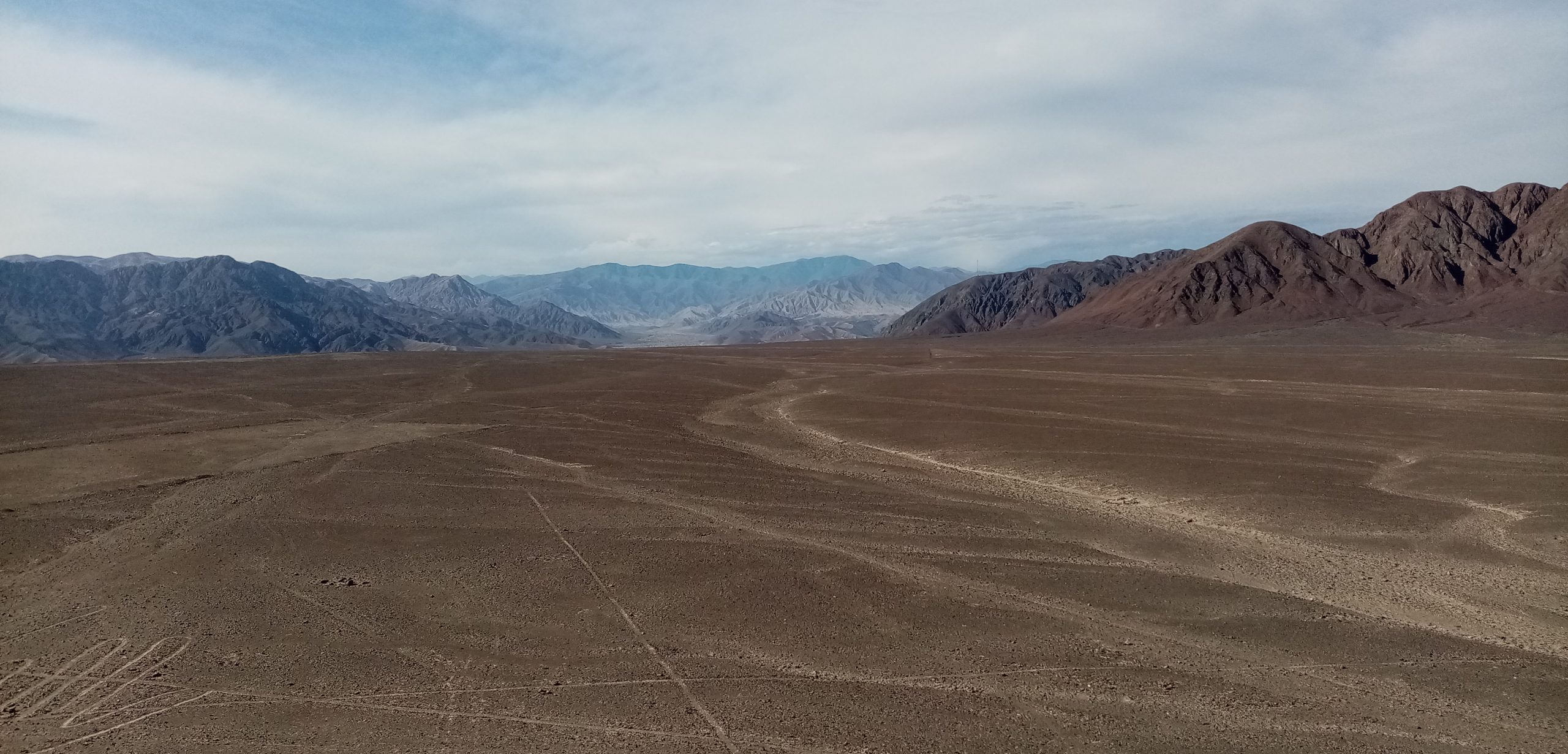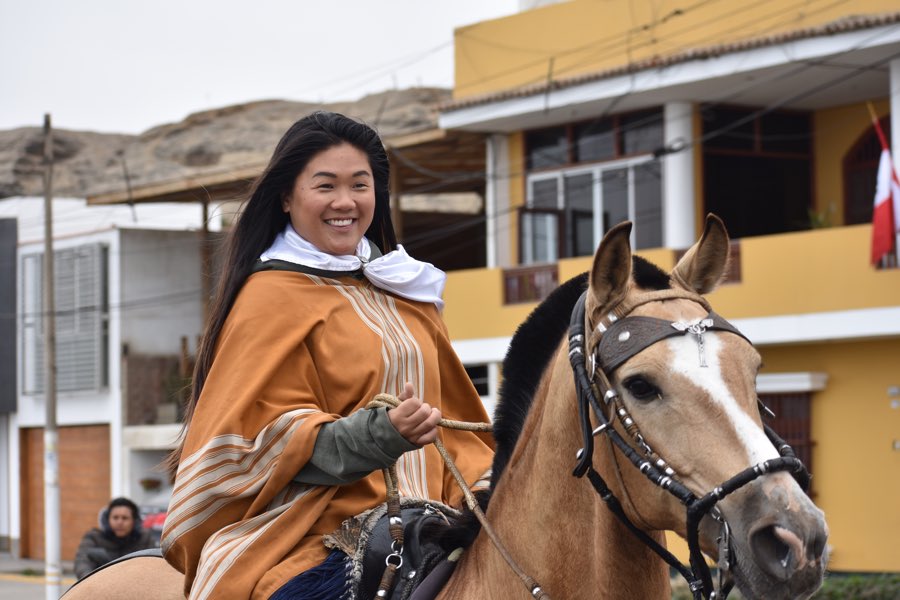In general, people visit Nazca to take a flight over the Nazca Lines. However, there are many other interesting sites to visit in this region. I will give you a brief overview here.
Most of the time, you start from Lima, then visit Paracas and perhaps Ica. Your next logical stop will be Nazca before heading to Arequipa and the Colca Canyon.
Nazca is a small town that I really liked. It’s quiet, easy-going, has good restaurants, and prices are more affordable than on the coast when it comes to dining. Moreover, there are a lot of archaeological sites and craft workshops to visit.
But let’s get back to the visits. I had hired a private guide who picked me up directly from my hotel. This way, we were able to visit 4 different sites around Nazca, but not always in the same direction! The first stop was the Chauchilla Cemetery, 30 km from Nazca.
Chauchilla Cemetery close to Nazca
The Chauchilla Cemetery is known for its well-preserved burials from the Nazca civilization. When you arrive early in the morning, there’s still a bit of mist on the mountain in front. The cemetery is near a river with villages and plantations below. Vito, my guide, explained to me that there must be several cemeteries like Chauchilla along the river, near different ancient communities. In fact, every village of the Nazca civilization had its own cemetery located near the village.
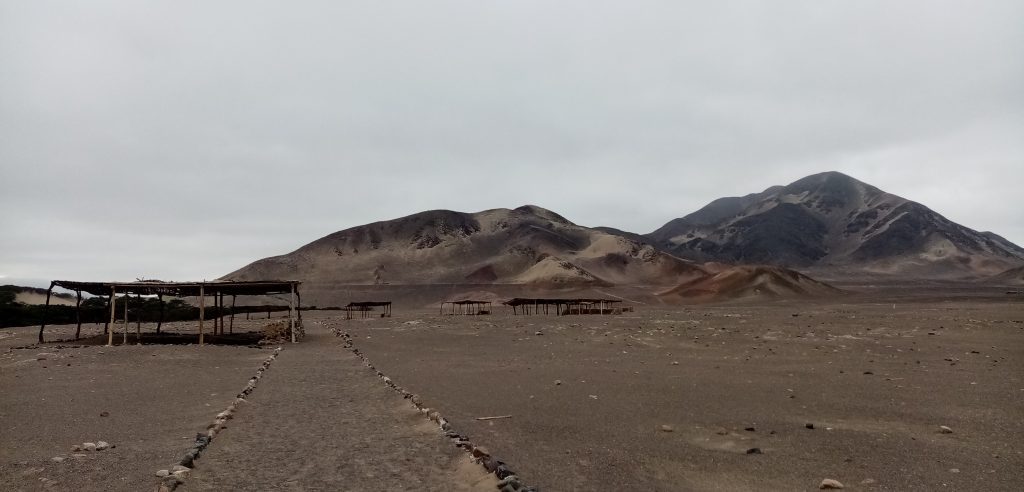
Key Information:
- The Chauchilla Cemetery houses tombs dating back to the Nazca civilization, between 200 BC and 600 AD. The Nazcas practiced complex burial rituals. The Chauchilla burials provide valuable insights into their traditions and culture. The Nazca civilization disappeared with the arrival of the Wari people.
There were about 700 tombs on site, which were initially not protected and were looted. Only 12 have been restored and can be visited today. Around the tombs, you can see “holes” in the landscape with remnants of cotton around them. These are excavations of other un-restored tombs, and the cotton comes from the mummies destroyed by looters. It was only about 50 years ago, with some tourism development, that people began to take an interest in what remained of the remains and started restoring them.
The Chauchilla burials were preserved due to the arid conditions of the Nazca desert. Mummies, bones, textiles, and funerary objects such as ceramics and offerings survived for centuries. Some of the mummies are remarkably well-preserved, with visible hair, fabrics, and even tattoos.
Layout of the Tombs
The tombs are arranged in groups, and each group is associated with a specific family or community. The tombs of common people were simple holes, but those of the elite were much more elaborate. They had adobe walls and were arranged like underground rectangular funerary chambers decorated with geometric patterns and murals.
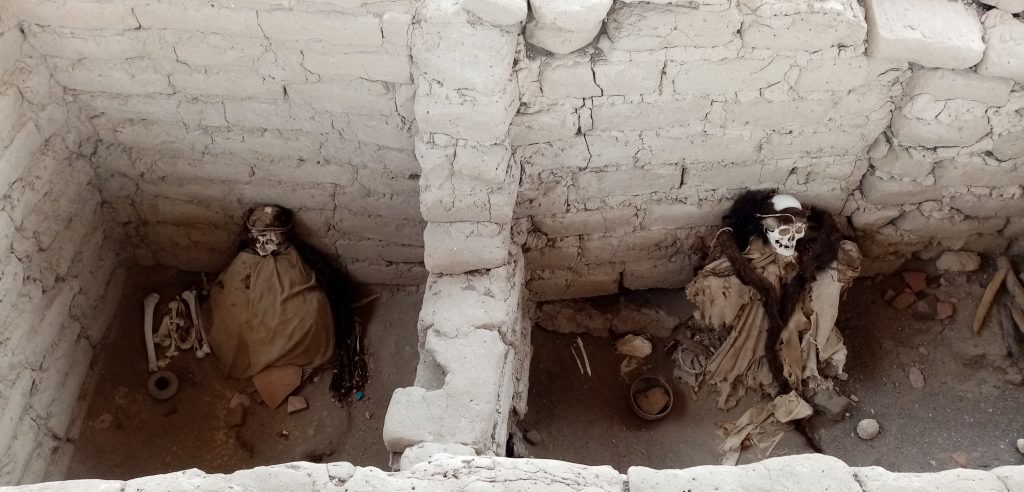
The Nazcas buried their dead in a fetal position, using the dehydration technique. Then they wrapped the body in cotton, depending on the social status of the deceased. The deceased was buried with all their personal belongings (ceramics, weapons, pets). The people of Chauchilla were relatively tall for their time, about 1.65 meters, and the leaders up to 1.70 meters. In fact, the elite were not buried in a fetal position but rather like the mummies in Egypt. They can also be identified by their deformed skulls, like those of the Paracas civilization.
All the mummies are placed in the tombs facing east, toward the sunrise, which must correspond to the rebirth of their bodies (after death).
Tips
To get from Nazca to Chauchilla, it takes about 30 minutes. The guided tour lasts about 1 hour. I highly recommend visiting the Chauchilla Cemetery with a Nazca guide. Local guides provide historical and cultural information about the site, allowing visitors to better appreciate its significance and history.
After visiting the cemetery, we returned to the main road to continue to the Cahuachi site, about 30 minutes away (part of it on a dirt and gravel road).
Cahuachi Archaeological Site, Nazca
The Cahuachi archaeological site is one of the most important and mysterious sites of the Nazca civilization, which thrived between 100 BC and 700 AD.
Cahuachi is considered the political and religious center of the Nazca civilization. It is a vast urban complex covering about 24 square kilometers. The site includes adobe pyramids (similar to those in northern Peru, in Trujillo or Chiclayo), courtyards, platforms, temples, and public squares. The structures are mainly made of adobe bricks, a building material made of clay and sand.
I was surprised by the restoration work, which dates back several years, but the adobe walls still look brand new! There is a kind of “varnish” on the adobe to protect it.
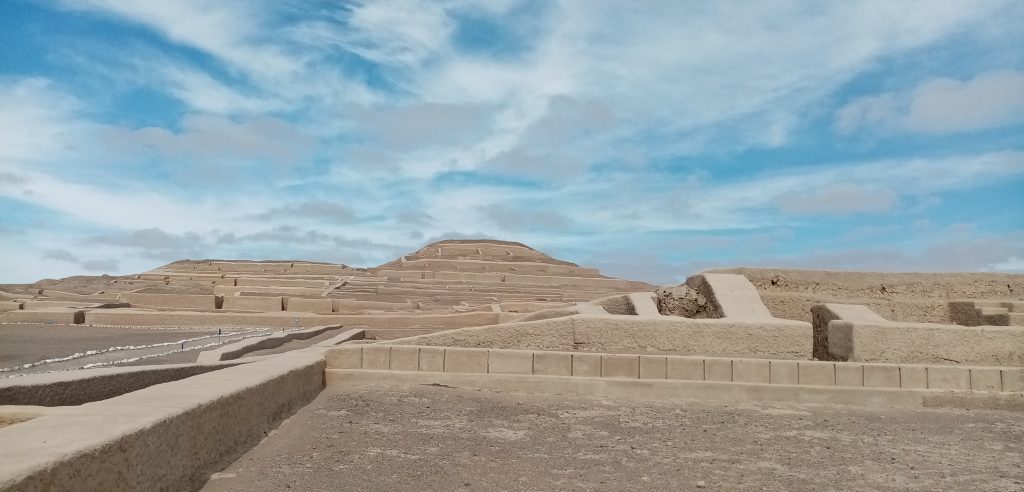
Key Information:
A distinctive feature of Cahuachi is its large truncated pyramids, with the largest one measuring about 28 meters in height. This one is currently not accessible to the public, but it is said to have contained a tomb with 50 llamas, 300 clay musical instruments, richly decorated, and 2 offering heads with deformed skulls!
The exact function of Cahuachi in Nazca society remains a subject of debate among researchers. Some believe it was a ceremonial center where the Nazcas practiced complex religious rituals. Others suggest it was also an administrative and political center.
The Cahuachi archaeological site was discovered in the 1920s, but systematic excavations only began in the 1970s. Archaeologists unearthed numerous ritual objects, textiles, ceramics, and mummies, which provide valuable insights into the life and culture of the Nazcas. Currently, only 5 out of the 100 pyramids are in the process of cleaning and restoration. In total, there were 9 sectors, each with about ten temples. Each temple had its specialized priest (such as the doctor, the rain priest, etc.).
I want to clarify that these 100 pyramids did not exist all at the same time. During the approximately 1,000 years of the Nazca civilization, the pyramids were built and buried. When a priest died, he was buried in his temple with his belongings and loved ones, and the site was abandoned, covered with sand, and disappeared.
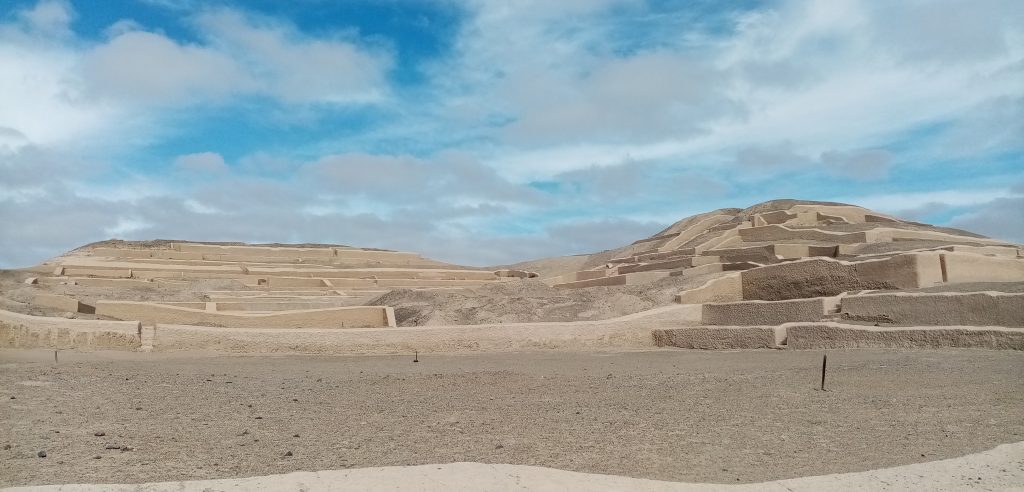
Impressive Effect!
The priests performed ceremonies in the plazas of their temple. To move around, they used long corridors that were 1.50 meters wide and 9 meters (!) high. So, the people did not see them moving. It was like a labyrinth, but open-air. The priests lived in underground dwellings, where they went back and forth through underground corridors. This allowed them to appear “magically” directly on the ceremonial square, perhaps even with a ceramic mask on their face. The effect on the people, in those days, must have been quite impressive!
It is said that the Cahuachi site ceased to exist in 500 AD due to a mega El Niño event that caused numerous landslides and destroyed the surrounding villages.
Tips
The Cahuachi site is open to visitors, and it is possible to explore the ancient structures and admire the remains of this ancient civilization. However, due to the fragility of the adobe structures, some parts of the site may be restricted to preserve its integrity. I recommend taking a guide to explain the history of the site; otherwise, you may miss out on this impressive location.
If you take a tour, you will generally be offered a visit to the Cahuachi site with a visit to the ceramics or textile workshop.
Indeed, that’s our next stop. The workshops of the artisans are located not far from the main road that leads back to Nazca. So, it’s on the way.
Textile and Jewelry Workshop in Nazca
In Nazca, you can find textile workshops that showcase traditional weaving and craftsmanship techniques used by the local population. These workshops offer visitors a unique opportunity to learn more about the art of weaving and participate in practical demonstrations.
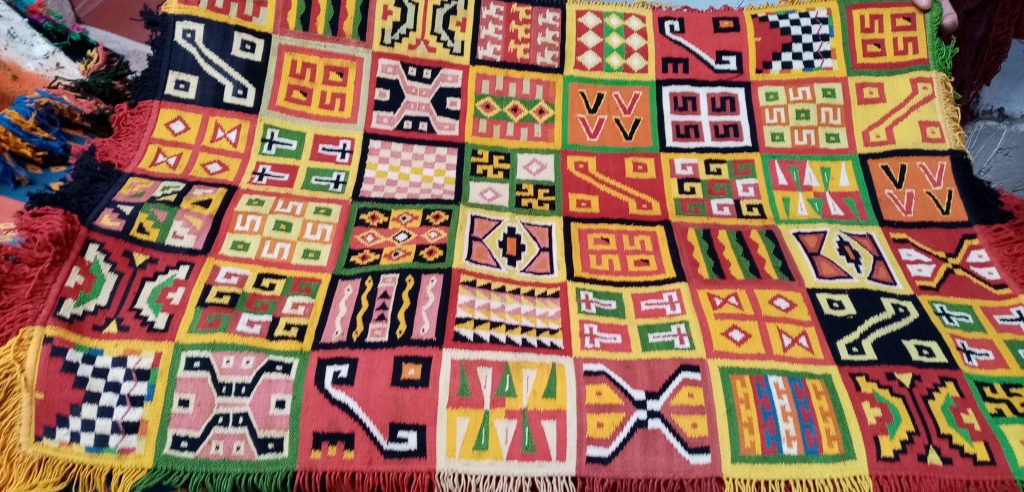
In my case, I visited the Textile Museum, where they produce not only textiles but also silver jewelry with semi-precious stones. At the museum, there are ten families from the Ayacucho region working. Seven of the families are involved in weaving, and the other three focus on making jewelry.
Creating Jewelry in Nazca
To create unique jewelry, the artisan first works the silver, either as a plate or as a thread. To make the silver harder, they alloy it with copper. Then, they shape it into the desired form and embed stones or mother-of-pearl. All these elements are prepared one by one before being assembled to create the jewelry.
First, they choose the stone or mother-of-pearl. Using various tools, the artisan polishes them to bring out their colors. Afterward, they cut the stone or mother-of-pearl to fit its shape (which could be a ring, a bracelet, or earrings). To embed the stones in the silver, they use eucalyptus resin, a natural fixative. They finish with polishing the finished jewelry to make the silver shine. Initially, they wash the jewelry and let it dry in a box filled with wood chips!
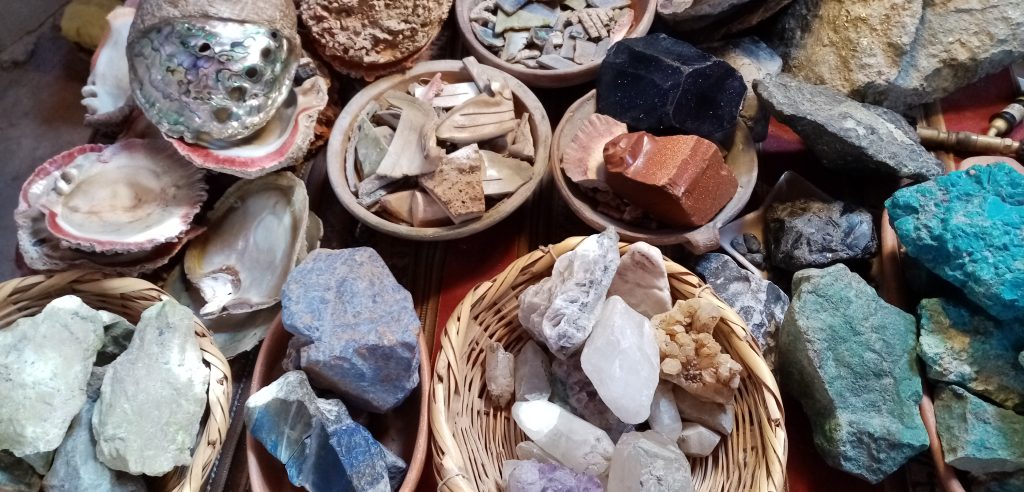
The creation of a piece of jewelry can take between 3 and 5 days, or even 10 days for the more complex ones!
After the jewelry demonstration, we move on to the weaving.
Creating Textiles
The artisan explains to me how they use cochineal insects to dye wool or cotton fabrics (naturally red, orange with lemon, violet with copper sulfate). Traditionally, human urine was used to fix the color, but today, they use alum.
Then he shows me the different stages of the weaving process, from preparing the threads to creating complex patterns on traditional looms. You can also learn more about the patterns and symbols used in Nazca fabrics, which often reflect elements of their culture, history, and environment.
I then visit the showroom, where I would have loved to buy a small bracelet because I find them really beautiful, but unfortunately, I don’t wear them myself, and as a small gift, they seem too expensive to me. So, I buy some embroidered fabric souvenirs that seem beautiful and original to me.
After the textile and jewelry workshop, we continue with the ceramics workshop, which is conveniently right next door!
Ceramics Workshop, Nazca
In Nazca, there are several ceramics workshops where visitors can discover and learn the traditional techniques of making Nazca pottery. In these workshops, you can learn the ancestral techniques used by the Nazca civilization to create pottery and ceramics. You’ll discover the methods of shaping, decorating, and firing the pieces.
The artisan who welcomes me explains that it was his grandfather who reconstructed the Nazca technique 50 years ago after numerous tests. The Nazca worked the clay by hand. Like the Huancas in northern Peru, they used tools (llama bones) only to smooth the clay.
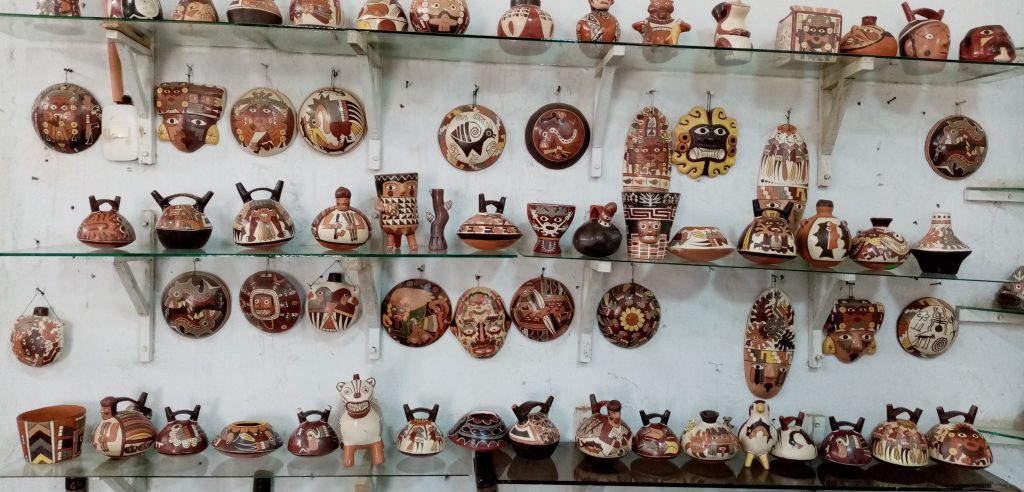
Once the desired shape is achieved, it’s time to paint the object. This is done with mineral paint that withstands high temperatures during firing (about 900°C). Firing takes place over a whole night according to a precise process. Afterward, to make the object shine, they use a special stone with the grease from the skin. He rubs the ceramic three times with the stone and then lets it dry in the sun for three days.
In the shop, Vito shows me several musical instruments that were made from clay and used at the time to create an atmosphere during ceremonies. There are ceramic trumpets and flutes.
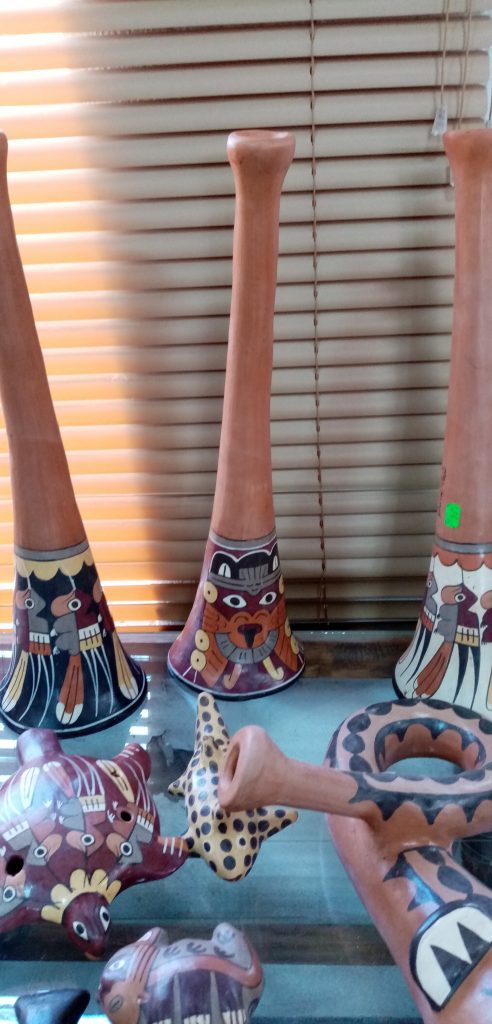
After a lunch break, we set off again, this time to various viewpoints to see the Nazca Lines and visit the Maria Reiche Museum (as I didn’t feel like taking the flight)
The Natural Viewpoint and Maria Reiche Viewpoint, Nazca
Natural Viewpoint
The natural viewpoint is located about 30 minutes from the center of Nazca. We climb a small hill from where we can see rectangular lines and squares. Vito explains to me that the Nazca people had only removed the top layer of stones and scratched the surface. This revealed the white sand beneath. The lines are not deep at all! They are naturally maintained by the winds on the plateau.
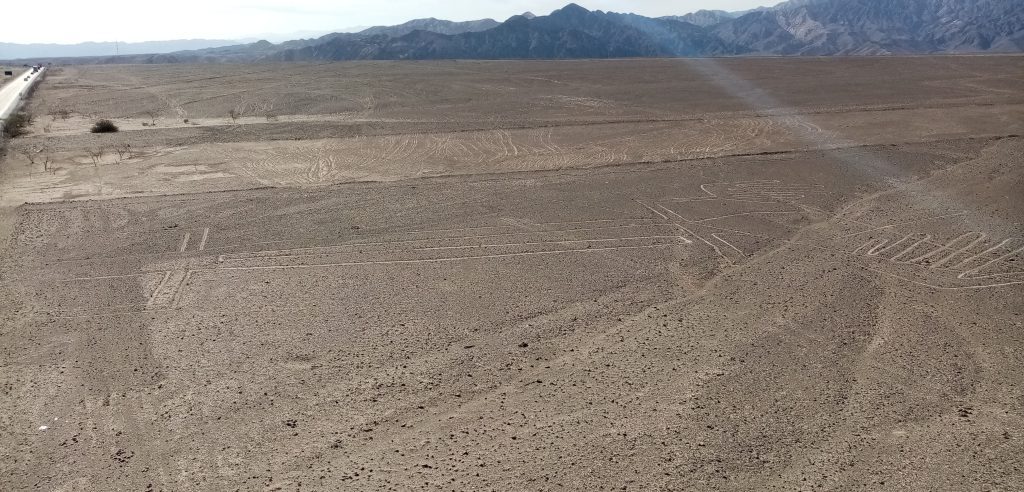
Maria Reiche Viewpoint
A few kilometers further from the natural viewpoint is the Maria Reiche Viewpoint. It was named in honor of Maria Reiche, a German researcher from Dresden. She dedicated a significant portion of her life to the study and preservation of these mysterious geoglyphs.
Maria arrived in Cusco at the age of 29 to teach the children of a wealthy family in Cusco. She did this for 9 years before spending 2 years in Lima. It was there that she first heard about the Nazca Lines. From the age of 40, she devoted herself entirely to the research of the Nazca Lines’ mystery. She passed away at the age of 95 in 1998.
The viewpoint is specifically designed to allow visitors to observe the Nazca Lines from an elevated platform. It offers a clear 360° view and allows you to appreciate the geometric shapes and patterns of the lines stretching endlessly in the Nazca desert. It’s an ideal place to observe and photograph the geoglyphs.
From the Maria Reiche Viewpoint, you can see several famous figures of the Nazca Lines, such as the tree, the hands, and the lizard.
Fun Fact: The lizard is actually cut in two by the highway. At the time of its construction, they didn’t know about the lines…
Attention!
Due to the sensitivity of the Nazca Lines to erosion and damage caused by visitors, it is strictly forbidden to walk or move on foot on the geoglyphs themselves. The viewpoint offers a respectful alternative that allows you to appreciate the lines while minimizing negative impacts on their integrity.
After visiting the viewpoints, we continue a bit further down the road to Maria Reiche’s House.
Maria Reiche’s House (Maria Reiche Museum)
The Maria Reiche Museum is dedicated to the famous German researcher Maria Reiche. Maria Reiche devoted much of her life to the study and preservation of the Nazca Lines, a set of pre-Columbian geoglyphs located in the Nazca desert.
The museum pays tribute to Maria Reiche. It presents her pioneering work in researching and interpreting the Nazca Lines. It houses a collection of artifacts, photographs, and documents related to her discoveries and research. You can learn more about her life, working methods, and contributions to understanding the Nazca Lines.
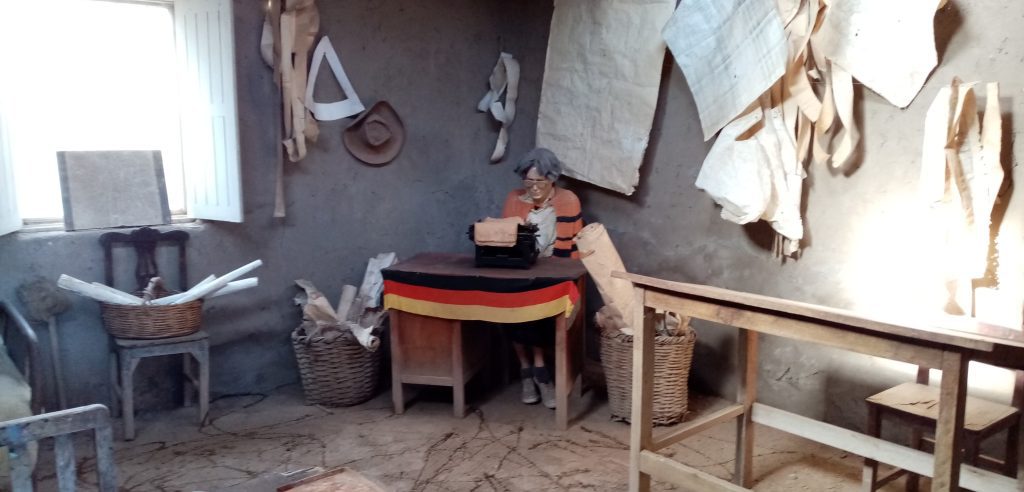
Good to know
Maria Reiche was poor; she had no property of her own. She was so fascinated by the lines that she slept under the stars, right next to her work. The locals thought she was crazy. At that time, no one understood what she was doing. But in fact, she was cleaning the lines, measuring them, mapping them, and relating them to Nazca beliefs, solstices, etc.
A neighbor who lived near the lines offered her a room for free in his hacienda where she eventually settled. He accommodated her so she could continue to focus solely on the lines!
Upon the owner’s death, he left the house to Maria Reiche. After her death, the house was transformed into a museum. You can see Maria’s room as she left it, with her various works, including maps. In the garden, you can even visit Maria Reiche’s grave, and her sister Renate, who joined her at the end of her life.
The museum and its garden remind me of the Los Horcones Hotel in Tucume with its lime houses, bougainvillea in the garden, a true oasis of tranquility.
A visit to the Maria Reiche Museum is an excellent way to better understand the importance of the Nazca Lines and Maria Reiche’s remarkable work in studying and protecting them. It’s also an opportunity to learn more about the Nazca civilization and its cultural heritage.
But the day is not over; we return to Nazca to head to the Cantalloc Aqueduct, my favorite visit in Nazca.
Cantalloc Aqueduct, Nazca
The Cantalloc Aqueduct is an ancient irrigation system. It was built by the Nazca civilization, which thrived in the region between 100 BC and 700 AD. So, it dates back to the same period as the Chauchilla Cemetery.
The Cantalloc Aqueduct consists of a complex network of underground and surface canals. They were designed to bring water from sources in the surrounding mountains to the agricultural lands of the Nazca Valley. This allowed the Nazcas to develop intensive agriculture, cultivating crops such as corn, potatoes, beans, and cotton in what is generally an arid region.
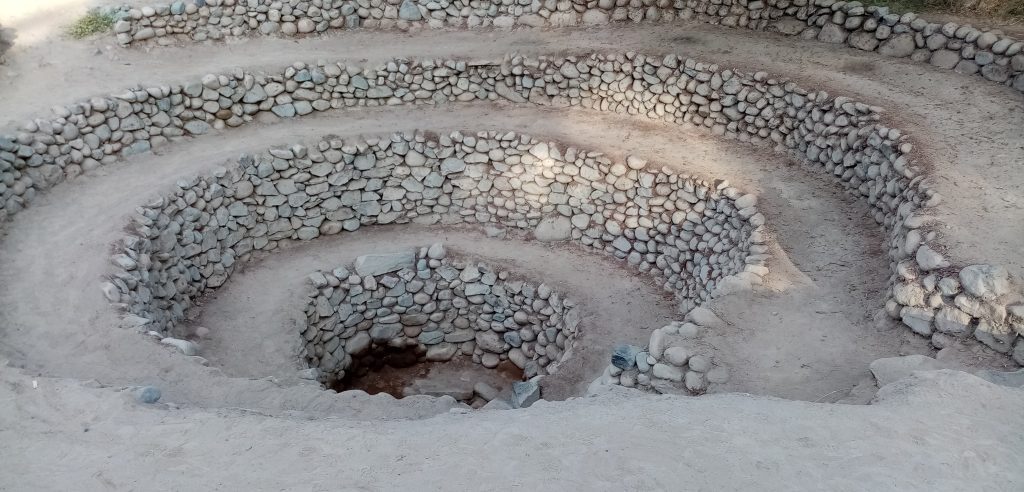
How the Aqueduct Works
What’s remarkable about the Cantalloc Aqueduct is its ingenious design. The underground canals were constructed using manual digging techniques. Stone slabs covered them to protect against collapses and infiltration. They captured groundwater through filtering galleries built without cement. Some of the underground canals are still used today for irrigating fields.
In addition, the Cantalloc Aqueduct features regularly spaced ventilation shafts. These allowed Nazca farmers to access the underground canals for maintenance and cleaning. These ventilation shafts also have spiral stairs, making access to water easier.
The canal itself is not linear; it zigzags to slow down the water’s flow and prevent damage to the walls. Large stones capture groundwater. Each well is spiral-shaped. There are small fish inside, a sign of water quality!
When there was a lot of water in the reservoir, the Nazcas opened the reservoir gates. This way, water irrigated the lands for 2 to 3 km to the next reservoir. There were about 10 aqueducts along the river to irrigate 30 km of land.
The Cantalloc Aqueduct is a testament to the ingenuity and technical mastery of the Nazca civilization in the field of irrigation. It demonstrates their ability to thrive in a challenging environment and develop productive agriculture in the region.
Taking Your Time
The place itself is beautiful. It’s a warm day, but it’s cooler in Cantalloc, with lots of trees and bougainvillea. A place that invites you to stroll and enjoy the landscape, where you can even discover another Nazca figure – a puma!
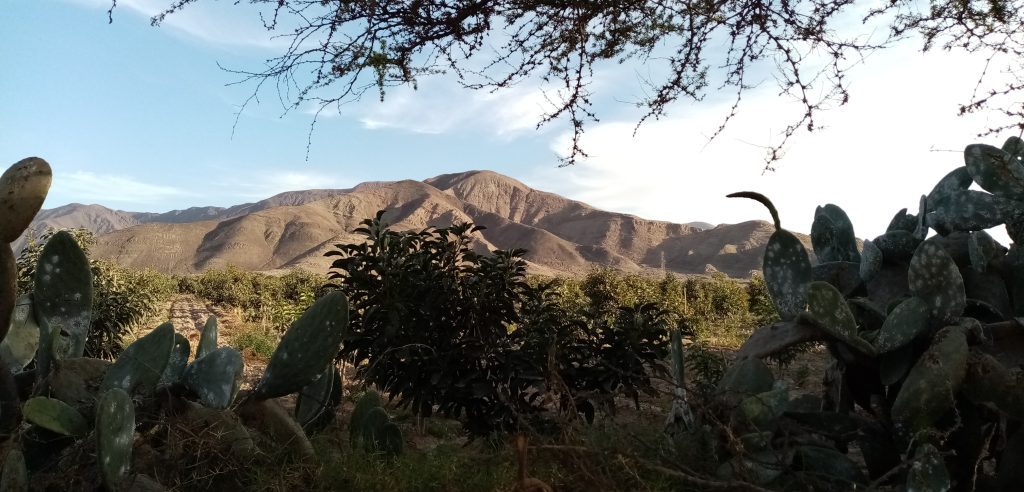
Today, visitors can tour the Cantalloc Aqueduct and even descend into some of the ventilation shafts. It’s a unique opportunity to see ancient engineering up close and appreciate the achievements of the Nazca civilization in irrigation and agriculture.
My guided tour ends with the visit to Cantalloc, and my guide drops me off at my hotel for some rest.
Because in the evening, I’ll return to the city center, to the Nazca Lines Hotel, to visit the Maria Reiche Planetarium. The French session is at 6:30 PM.
Maria Reiche Planetarium
The Maria Reiche Planetarium is a specific facility that offers experiences related to astronomy and the Nazca Lines.
After paying the entrance fee, we wait in the waiting room. It’s a chance to look at the courtyard of this 4-star hotel. At exactly 6:30 PM, the guide arrives and takes us through the hotel to a nearby place where the planetarium is located, a round building with a dome.
How the Visit Unfolds
We first watch a video about the Nazca Lines and the different theories they have inspired. Periodically, the guide activates a sphere of the sky, which is projected brightly onto the dome. The sphere explains the information from the video.
After these explanations about astrological signs, he shows us a short video about Maria Reiche. Maria stayed in a room at this hotel, always accommodated and fed at the owner’s expense, at the end of her life. The room still exists, closed with a commemorative plaque in front. Apparently, they are going to turn it into a museum. The guide is full of admiration for Maria Reiche, to whom, according to him, the Peruvians owe a lot. She was even naturalized as a Peruvian before her death.
After the videos, we go back out into the courtyard, and the guide brings out a large telescope, allowing us to look at the moon. It’s incredible how close you can see it! I can even see the craters on the moon.
The visit lasts about an hour.
Tip
If you’re traveling to Arequipa after Nazca, it’s probably by night bus. The visit to the Planetarium will help you pass the time until the bus departs.
How to Get to Nazca
To get to Nazca, several transportation options are available depending on your starting point and preferences. Here are the main options for getting to Nazca:
- By bus: You can reach Nazca via a good bus network from various cities in Peru. Lima is one of the most common destinations for bus travel to Nazca. Buses from Lima to Nazca take approximately 7 to 8 hours, depending on the chosen service. Other cities like Arequipa and Cusco also offer bus routes to Nazca, usually overnight.
- By car: If you prefer to drive, you can rent a car and drive to Nazca from Lima or other nearby cities. The Pan-American Highway South connects Lima to Nazca, and the journey typically takes about 5 to 6 hours depending on traffic conditions.


